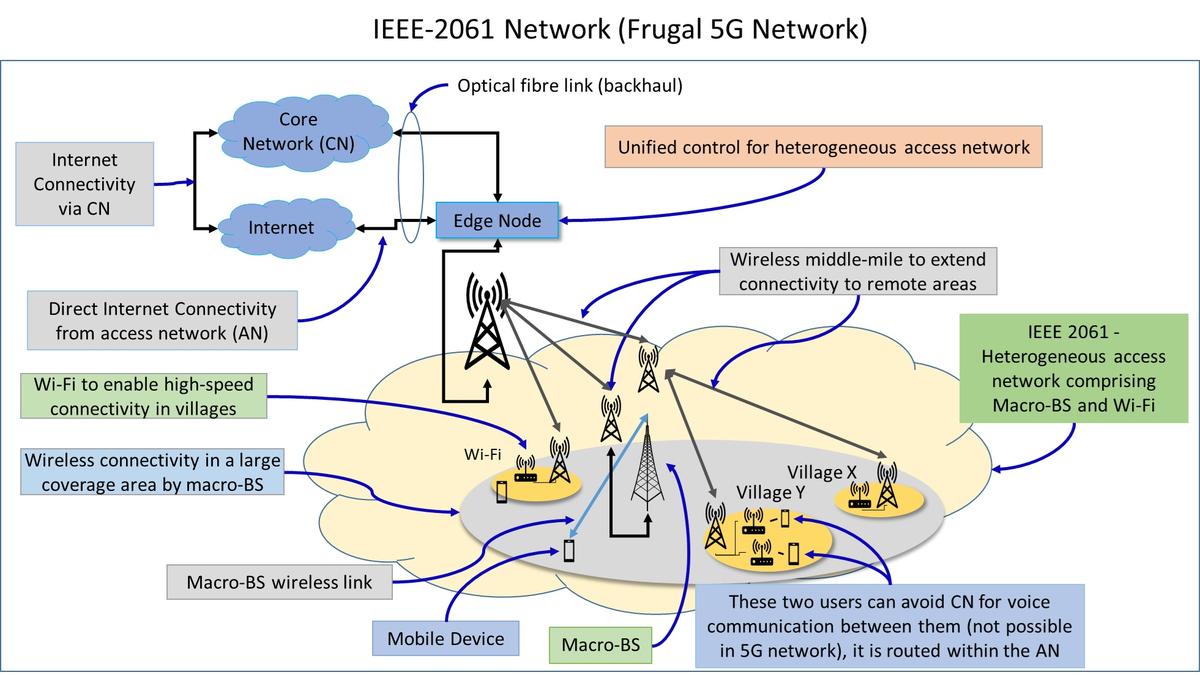From UPSC perspective, the following things are important :
Prelims level: What is a middle-mile network?
Mains level: What impedes rural connectivity?
Why in the news?
On June 6, IEEE endorsed a wireless network structure aimed at providing economical broadband access in rural areas, formulated at IIT Bombay.
About the latest Telecom Subscription Data
- Urban Tele-density: Urban tele-density in India is 127%, indicating that on average, each urban user has more than one mobile connection.
- Rural Tele-density: Rural tele-density is significantly lower at 58%, meaning only about one in two rural residents has a mobile connection.
- Urban-Rural Digital Divide: The data highlights a stark contrast between urban and rural areas, with urban areas having much higher mobile connectivity compared to rural regions, reflecting a significant digital divide.
What are access and core networks?
- Access Network (AN): The AN consists of base stations that provide wireless connectivity to mobile devices within a limited geographical area. It interfaces directly with mobile devices, facilitating communication and data transfer between devices and the wider network.
- Core Network (CN): The CN comprises centralized network equipment that manages and directs data traffic between the access network, other networks (like the Internet), and service providers. It handles tasks such as routing, switching, and managing connectivity across the broader network infrastructure.
What impedes rural connectivity?
- Affordability: Lower income levels in rural areas make mobile services relatively expensive, limiting access for many rural residents.
- Cost of Infrastructure: Installing and maintaining network infrastructure like fibre optics in remote rural areas is costly and may not be economically viable for service providers.
- Low Population Density: Rural areas often have sparse populations spread over large geographic areas, making it less profitable for network operators to invest in infrastructure deployment.
- Geographical Barriers: Difficult terrains and remote locations further complicate the installation of base stations and backhaul infrastructure necessary for robust network coverage.
- Urban Bias in Technology: Most advancements in cellular networks, such as 5G, prioritize high data rates and low latency suitable for urban environments, neglecting the unique challenges of rural areas.
- Limited Research: There has been insufficient research focused on developing cost-effective solutions that can efficiently cover large rural areas with adequate connectivity.
What is the IEEE 2061-2024 standard? (Its working and architecture)
- IEEE 2061-2024 aims to establish a standardized wireless network architecture for affordable broadband access in rural areas.
- It defines a heterogeneous Access Network (AN) comprising macro base stations (Macro-BS) and Wi-Fi base stations, integrated with a flexible Core Network (CN) bypass capability.

Architecture:
- Heterogeneous AN: Includes Macro-BS covering large areas with potentially lower data rates, complemented by Wi-Fi base stations deployed within villages for high-speed connectivity.
- CN Bypass: Allows direct Internet access from the AN, bypassing the centralized Core Network for certain communications. This enhances efficiency and reduces latency, catering to stationary users common in rural settings.
- Middle-Mile Connectivity: Utilizes multi-hop wireless networks (e.g., satellites, long-range Wi-Fi) to extend connectivity over long distances where optical fibre deployment is impractical or costly.
What is a middle-mile network?
- A middle-mile network refers to the infrastructure that connects core network hubs to local access points, spanning intermediate distances. It uses technologies like fibre optics, microwave links, or satellites to transport data between central and regional locations, facilitating efficient connectivity over longer distances without the need for direct local access networks.
Conclude: To bridge the urban-rural digital divide in telecom, measures should focus on affordability through subsidized services, incentivizing infrastructure investment in rural areas, promoting research on rural-specific technologies, and ensuring equitable access to advanced wireless standards like IEEE 2061-2024.
Mains PYQ:
Q Has digital illiteracy, particularly in rural areas, coupled with a lack of Information and Communication Technology (ICT) accessibility hindered socio-economic development? Examine with justification. (UPSC IAS/2021)
Get an IAS/IPS ranker as your 1: 1 personal mentor for UPSC 2024

